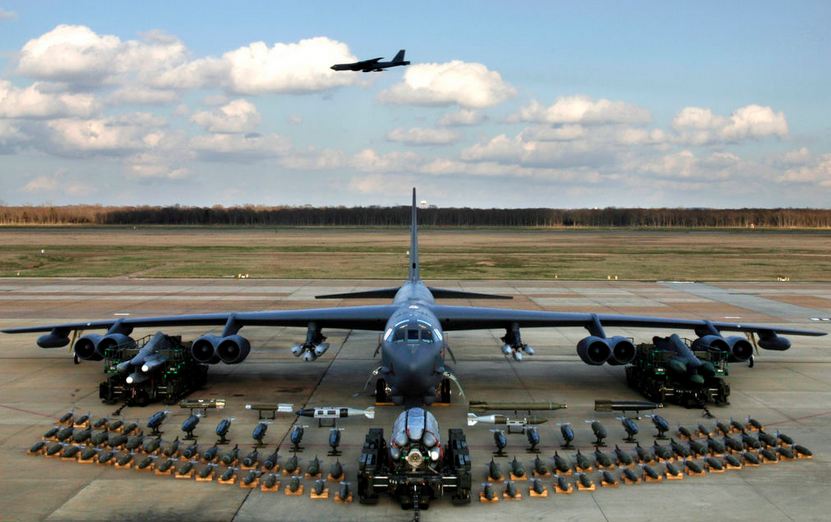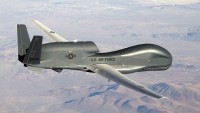US Deploys B-2 Nuclear Stealth Bombers to Guam to Join B-1B and B-52 Bombers Already on the Island
| Arthur Dominic Villasanta | | Aug 10, 2016 11:25 PM EDT |
(Photo : USAF) A B-52H, B-1B and B-2 bomber stand ready at Andersen Air Force Base on Guam.
The United States has massively increased its offensive air power in Asia with the unannounced deployment yesterday of three B-2 "Spirit" nuclear-capable stealth bombers to Guam.
The U.S. Air Force B-2s join the B-1B "Lancer" long-range strategic bombers and B-52H bombers currently based on the island, which has been transformed into the major staging base for the Air Force should a conflict against China arise over the South China Sea.
Like Us on Facebook
The arrival of the B-2s at Andersen Air Force Base was a surprise since the Pentagon had previously announced B-1Bs were to be deployed to Guam to replace the B-52Hs currently patrolling Asian airspace. This is one of the very rare instances when all three U.S. strategic bombers have been based at one base at one time.
An undetermined number of B-1B Lancers of the U.S. Air Force have also arrived in Guam even as tensions at the South China Sea flared with news China is hardening its military aircraft hangars on the Spratly Island islets it seized from the Philippines against U.S. air attack.
The B-1Bs, which has the largest internal payload of any U.S. bomber and can fly at speeds of up to Mach 1.25 (1,335 km/h), will be based at Andersen Air Force Base in Guam. Accompanying them are some 300 airmen from Ellsworth Air Force Base in South Dakota, which is the home base for these aircraft.
The Lancers are replacing B-52 bombers from Minot Air Force Base in North Dakota that have been on Guam as part of the United States Pacific Command's (USPACOM) "Continuous Bomber Presence" mission.
"These bomber deployments visibly demonstrate our readiness and commitment to the Indo-Asia-Pacific region," said US Air Force Gen. Terrence O'Shaughnessy, commander of the Pacific Air Forces (PACAF), which is part of USPACOM.
"Bomber aircraft provide the USPACOM area of responsibility with an effective deterrent capability, ensuring the regional security and stability of the US and our allies and partners."
PACAF noted China's increasingly aggressive behavior in militarizing the South China Sea and its open talk of war make the deterrent value of the B-1B more important to maintaining peace in Asia.
It said the Lancers "will provide a significant rapid global strike capability that enables our readiness and commitment to deterrence, offers assurance to our allies and strengthens regional security and stability."
PACAF said that with "a large weapon capacity and exceptional standoff strike capability, the B-1 will provide the U.S. Pacific Command and its regional allies and partners with a credible, strategic power projection platform."
The deployment of this strategic bomber optimized for devastating low-level attacks is the United States' reply to China's illegal militarization of the disputed South China Sea. This follows a ruling by an international tribunal that declared illegal China's claim to own this body of water based on "historic rights."
As part of the Continuous Bomber Presence mission in the Pacific, the US has regularly kept bombers stationed at Andersen Air Force Base in Guam. The U.S. has, however, replaced its old B-52 bombers with the newer B-1 and B-2 Spirit stealth bombers.
The planes were positioned in the Pacific by U.S. Strategic Command (STRATCOM), which commands fleets of bombers, many of which are nuclear-capable, to maintain stability and deter potential threats.
"Our strategic bomber force routinely operates around the globe and with our regional allies and partners, and this deployment is one such demonstration of the US commitment to supporting global and regional security," said US Navy Adm. Cecil D. Haney, STRATCOM's commander.
Last June, the B-52s were deployed to Guam alongside the USS John C. Stennis and USS Ronald Reagan carrier strike groups in a show of force that likely kept China from attacking the Philippines. The B-52s' deployment coincided with a squadron of EA-18G electronic warfare jets to Clark Air Base in the Philippines.
TagsB-2 "Spirit" nuclear-capable stealth bombers, B-1B Lancer, B-52H, Guam, Andersen Air Force Base, South China Sea, U.S. Air Force
©2015 Chinatopix All rights reserved. Do not reproduce without permission
EDITOR'S PICKS
-

Did the Trump administration just announce plans for a trade war with ‘hostile’ China and Russia?
-

US Senate passes Taiwan travel bill slammed by China
-

As Yan Sihong’s family grieves, here are other Chinese students who went missing abroad. Some have never been found
-

Beijing blasts Western critics who ‘smear China’ with the term sharp power
-

China Envoy Seeks to Defuse Tensions With U.S. as a Trade War Brews
-

Singapore's Deputy PM Provides Bitcoin Vote of Confidence Amid China's Blanket Bans
-

China warns investors over risks in overseas virtual currency trading
-

Chinese government most trustworthy: survey
-

Kashima Antlers On Course For Back-To-Back Titles
MOST POPULAR
LATEST NEWS
Zhou Yongkang: China's Former Security Chief Sentenced to Life in Prison

China's former Chief of the Ministry of Public Security, Zhou Yongkang, has been given a life sentence after he was found guilty of abusing his office, bribery and deliberately ... Full Article
TRENDING STORY

China Pork Prices Expected to Stabilize As The Supplies Recover

Elephone P9000 Smartphone is now on Sale on Amazon India

There's a Big Chance Cliffhangers Won't Still Be Resolved When Grey's Anatomy Season 13 Returns

Supreme Court Ruled on Samsung vs Apple Dispute for Patent Infringement

Microsoft Surface Pro 5 Rumors and Release Date: What is the Latest?












